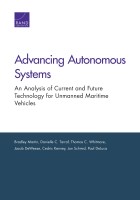| 来源类型 | Research Reports
|
| 规范类型 | 报告
|
| DOI | https://doi.org/10.7249/RR2751
|
| 来源ID | RR-2751-NAVY
|
| Advancing Autonomous Systems: An Analysis of Current and Future Technology for Unmanned Maritime Vehicles |
| Bradley Martin; Danielle C. Tarraf; Thomas C. Whitmore; Jacob DeWeese; Cedric Kenney; Jon Schmid; Paul DeLuca
|
| 发表日期 | 2019
|
| 出版年 | 2019
|
| 页码 | 120
|
| 语种 | 英语
|
| 结论 |
Autonomous systems for military applications are not on pace for the proposed future fleet, but some of the more promising uses of autonomy are not being exploited- Advances in autonomy have been steady, but the transition to systems capable of reacting to unexpected changes in the environment has not occurred and might not occur for several years.
- The military applications contemplated for unmanned vehicles are unlikely to be developed without substantial military investment and development.
- The limiting features associated with the most-complex missions are not necessarily associated with autonomy, and it might not be useful to accelerate autonomy while such issues are still being worked out.
- Under current kill chains and concepts of operation, autonomy is generally employed to replicate items in the kill chain exactly as they are carried out by manned systems.
- The alignment between the expected future fleet and possible future uses of autonomy is not close, and author analyses suggest that some features desired for the future fleet are unlikely to be reached under the known program of record.
- Policy issues related to autonomous systems applying rules of engagement do exist, and it is unlikely that these systems will be engineered in a way that avoids these issues. Slowing the decisionmaking of autonomous systems by interposing a human in the loop will likely cede a critical time advantage in a high-intensity environment. This delay is a choice and cannot be mitigated by technical improvements.
- Some of the more promising uses of autonomy might be in using simple systems with limited autonomy for most functions — but adding the capacity for the systems to coordinate with each other.
|
| 摘要 |
- The Navy should revisit assumptions concerning technological progress in autonomy. The research indicates that the capability for autonomous systems to interpret context and make independent decisions, particularly in a dynamic environment, is not realistic in the short term.
- The Navy should align the development of autonomy with the development of other capabilities, such as power generation and storage, that might be limiting factors.
- The Navy should use the unique features of autonomy to enable new concepts of operation. It seems particularly promising to employ simple but numerous systems carrying different kinds of sensors.
- The Navy should accept the reality that autonomous systems will need to make engagement decisions if those decisions are to be effective. Modern weapon system timelines simply preclude human intervention.
- The Navy should develop a mechanism that allows humans to periodically assess whether an autonomous system is misinterpreting its environment.
- The Navy should critically evaluate the viability of complex multimission platforms and consider emphasizing simple but cooperating platforms.
|
| 主题 | Autonomous Vehicles
; Electronic Warfare
; Military Information Technology Systems
; Military Ships and Naval Vessels
; Naval Warfare
; Submarines
; United States Navy
|
| URL | https://www.rand.org/pubs/research_reports/RR2751.html
|
| 来源智库 | RAND Corporation (United States)
|
| 引用统计 |
|
| 资源类型 | 智库出版物
|
| 条目标识符 | http://119.78.100.153/handle/2XGU8XDN/108965
|
推荐引用方式
GB/T 7714 |
Bradley Martin,Danielle C. Tarraf,Thomas C. Whitmore,et al. Advancing Autonomous Systems: An Analysis of Current and Future Technology for Unmanned Maritime Vehicles. 2019.
|
|
文件名:
|
x1546613136139.jpg
|
|
格式:
|
JPEG
|

|
文件名:
|
RAND_RR2751.pdf
|
|
格式:
|
Adobe PDF
|
除非特别说明,本系统中所有内容都受版权保护,并保留所有权利。